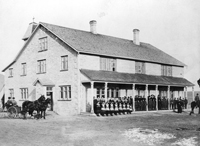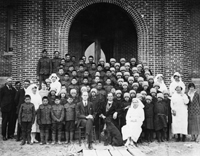| Social Studies | Close this window |
 |
Return to Making Connections to Land, People and Places |  |
Love Thy Neighbour: Repatriating Precarious Blackfoot Sites
Authors: Cynthia M. Chambers & Narcisse J. Blood
|
A StoryWe want to tell you a story; it is an old story, one you may have heard before but like most important stories it bears repeating. Just as the bundles have to be opened each year always in the same way, just as the Sundance is held each summer at the same place and in the same way, these stories must be told so that the memories are continually renewed. Repeating these stories is also necessary because not all indigenous people and even fewer non-Indigenous people know this story. The citizens of Alberta, including all those being represented in the bundles—ksahkomitapiiksi or earth beings (plants, rocks, animals), spomitapííksi or above beings (spiritual beings, celestial beings, birds) and soyíítapiiksi or under-water beings (fish, amphibians, reptiles, water birds and mammals)—are living with effects of these events. This story is important for everyone living in present-day Alberta. This story needs to be told, even if it offends, although it is not intended to do so. It is too important to forgot. This story begins about one hundred years ago, maybe longer. A series of historical traumas in the nineteenth century—disease, famine and massacre—made it very difficult, if not impossible, for Siksikáitapiiksi means of knowledge transfer to remain intact. Successive waves of smallpox spread through intertribal trade even prior to actual contact with the Europeans. Oral accounts estimate that one quarter to one third of the people perished with each outbreak and that over one half of the people died in the 1837 epidemic alone.i At the confluence of Náápi Otsíí’tahtaan (Oldman River) and Iisskstaáí’tahtaan (St. Mary’s River) near present-day Lethbridge so many Káínai perished that the site is called Akáíí’nisskoo or Many Dead.ii When smallpox killed everyone inside a tipi, the flap was sewn shut, and this warned those who approached of the contagious death within. At Many Dead, the sewn-shut death lodges are now all gone. What remains is a series of tipi rings, a circle of stones used to hold the tipi and its liners in place. But the stone rings for the death lodges are different. A tipi has a doorway facing east, marked by a break in the circle of stones. In a death lodge, the entrance was closed, the stone circle complete. Complete circles of stone, without a doorway facing east, are evidence of these ii’noiyis or death lodges. Such circles can be found all over Southern Alberta, including near the walking trails of Lethbridge. They memorialize not only the massive death but also the effects of the epidemics on the people. Epidemic and famine can sound innocuous, as if there were no perpetrator, as if the near decimation of a people is the inevitable result of natural events, perhaps even fated. This was especially true for the Niitsítapiiksi, where historical and ethnographic accounts written by Náápiikoaiksi almost normalize famine, as if it were a natural part of life for a “primitive nomadic” people, “subsisting” on a single, unpredictable food source, the “migrating” buffalo herds. So when the bison, whose numbers were estimated to be anywhere from thirty to seventy million prior to European contact, were deliberately and violently decimated within a few short decades, the resulting famine was naturalized.iii Sayings such as the buffalo “vanished” or “disappeared” are part of everyday English discourse. These euphemisms are taken-for-granted in curriculum, textbooks, trade books and popular culture and go unnoticed. Better to say the buffalo “vanished,” as if by magic, than to admit they were massacred without regard for the effect on all the prairie peoples: Siksikáítapiiksi (Blackfoot), Asinaa (Cree), Atsíína (Gros Ventre), and Issapó (Crow). While loss of the buffalo was devastating for the people, the ecosystem and landscape of the entire Great Plains was irrevocably altered: the wolves, vultures, and grizzly bear lost their source of food and abandoned the prairies; the grasslands were no longer grazed, as only the buffalo could graze them; the people no longer set fire to the grass to force new growth and attract the herds. The decimation of the bison had a domino effect. By the 1870s, the only remaining bison herds were the few in kitáóowahsinnoon (the land which nourishes us). Siksikáítapiiksi soon found themselves under great pressure to protect the land and the bison from the other First Nations who were starving because there were no more bison in their territories: Asinaa (Cree), Niitsísinaa (Assiniboine), Atsíína (Gros Ventre), Issapó (Crow) and Kai'spa (Lakota/Daktoa or “parted hair”). Thus Siksikáítapiiksi had to fight with former allies such as the Asinaa (Cree). While other First Nations wanted access to the last remaining bison herds, the settler governments–the new Dominion of Canada in Alberta and the United States government in Montana–wanted the land and dominion over it. The slaughter of the bison was not the only massacre perpetrated. The events of 23 January 1870 live on in the collective memory of the Siksikáítapiiksi. That cold winter day, the men of Heavy Runner’s camp had gone hunting. At dawn, the United States Calvary, under the command of Major Eugene Baker, attacked the camp and slaughtered over 300 unarmed women, children and old men.iv The survivors fled north and took refuge on the Canadian side of the 49th parallel, isskskáakssin. The Aamsskáápipikáni (South Peigan or Montana Blackfeet) of Heavy Runner’s camp joined their northern relatives at just below the confluence of the Náápi Otsíthaatan (Oldman River) and the Iisktaitahtaan (St. Mary’s River), near present-day Lethbridge. It is at that place the Asinaa (Cree) found the Siksikáítapiiksi (Blackfoot) camped in the autumn of 1870. The Asinaa (Cree) had headed west to Blackfoot territory seeking both revenge for previous wrongs and access to the remaining bison. Even with advantage of surprise, attacking at early dawn, hundreds of Cree were killed. The combined numbers of Akáínaa (Bloods), Aapátohsipikáni (North Peigan), and Aamsskáápipikáni (South Peigan or Blackfeet) allowed the Siksikáítapiiksi to overwhelm their attackers. There is a plaque, in the river bottom of present-day Lethbridge, which commemorates this “last big battle” between the Siksikáítapiiksi (Blackfoot) and the Asinaa (Cree). The battle scene in Lethbridge and the “Baker Massacre” on the Bear (Marias River in Montana) are both sites of historical trauma, yet, the massacre in Montana remains unmarked: no cairn, no plaque. This dark period is marked in the memory of the Siksikáítapiiksi, commemorated in the stories told and re-told. In the early part of the nineteenth century, Siksikáítapiiksi (Blackfoot) protected their territory and resources fiercely. In spite of continuous attempts to encroach on their territory, Siksikáítapiiksi kept fur traders and missionaries at bay as long as they could. American traders eventually won access to kitáóowahsinnoon and the Siksikáítapiiksi, in part by escalating the exchange of whisky for furs and bison hides, angering the Hudson Bay Company who believed their charter gave them a monopoly on trade with the Blackfoot. In 1873, the newly formed civilian police force, the Northwest Mounted Police (NWMP) marched west, supposedly to suppress the illegal whisky trade. The people’s stories say otherwise. The late Dan Weasel Moccasin recounted how NWMP soldiers would ride into Siksikáítapiiksi camps with booze hidden in their saddlebags. The men would approach Blackfoot women and point to their saddlebags, initiating a different kind of trade than the one they were there to halt. All of these forces—disease, starvation, warfare and whisky—were in play by 1877 when Red Crow and Crowfoot and other leaders made treaty with the Dominion of Canada, a young British colony concerned about the expansion of American interests north of the 49th parallel. One result of Treaty 7 was that the Káínaa, Piikáni and Siksiká were eventually confined to separate tracts of land within kitáóowahsinnoon. Called “reserves,” the pieces of land “set aside” were miniscule in comparison to the size of the traditional territory. Siksikáítapiiksi do not believe the true spirit and intent of the treaty discussions and agreements were honoured (Treaty 7 Elders & Tribal Council with Hildebrandt, First Rider, & Carter, 1996). The size of the reserves is only one of many outstanding issues from the original treaty.v Through the treaty process, First Nations across the prairies were exiled to small tracts of land within their homelands. The people and their knowledge were incarcerated within the boundaries of the reserves, separated from kitáóowahsinnoon. Indian agents and the NWMP restricted people’s movements across those boundaries. Like the Berlin Wall, reserve borders changed everyone’s consciousness about what constituted traditional territories. It also severed the relationships amongst the Siksikáítapiiksi themselves (Káínaa, Piikáni, and Siksiká) and between each group and kitáóowahsinnoon. The reserve boundaries also changed the relationships between the Niitsítapiiksi (Blackfoot) and the Náápiikoaiksi (settler peoples). Shortly after the signing of Treaty 7, the churches built and operated residential schools with funding from the Canadian government.vi In these schools, children lived for years at time, separated from their families, their communities and their language. The experience of these schools further severed the people from their memory of the land that once sustained them and gave them identity as Niitsítapiiksi. Throughout all of this consciousness of Blackfoot territory became colonized: the “rez” became the homeland, while Náápiikoaiksi occupied all of the remaining kitáóowahsinnoon. i The 1837 smallpox outbreak was recorded in a Blackfoot winter count (Raczka, 1979). We recommend J. C. Ewers (1958) historical and ethnographic introduction to the Blackfoot, which includes the devastation caused by smallpox. ii Prior to the establishment of the trading forts, this site was called “Many Berries.” Over time with the deaths from smallpox and liquor, the name took on a double meaning: “many berries” and “many deaths.” iii The written literature on the buffalo, particularly on the Blackfoot and the buffalo, is extensive. We refer the reader to Jack W. Brink (2008) Imagining Head-Smashed-In: Aboriginal buffalo hunting of the northern plains (Edmonton, AB: Athabasca University Press) for an extensive review of the literature on bison and bison hunting primarily from a Western archaeological perspective. Chapter 9 in particular summarizes the historical record on the demise of the bison in the nineteenth century. iv While official reports of the massacre give 173 as the number dead, Darryl Kipp, Director of the Blackfoot Immersion for Blackfeet Reservation in Montana, states that oral accounts place the number of dead at over 300. v The first (printed) treaty, between Siksikáítapiiksi and Náápiikoaiksi, was the Lame Bull Treaty 1855 negotiated and signed at a council held mouth of the Ootahkoaisisatan (Yellow River named by William Clark, the Judith River) in present-day Montana. See Ewers, 1958 and www.trailtribes.org. vi St. Joseph’s (Dunbow near Calgary, 1884); St. John’s Boarding School (now called Old Sun’s at Siksikáí, 1894), St. Paul’s Anglican Mission and St. Mary’s Immaculate Conception (both located on Káínaa). (See Glenbow Archives available at www.glenbow.org). Figure 2: St. Joseph’s Industrial School, commonly known as Dunbow. High River area, circa 1890s. Courtesy Glenbow Archives, NA-2172-7. Like refugees exiled to a foreign country, Siksikáítapiiksi’s memories of kitáóowahsinnoon lives in the stories they tell. But when Siksikáítapiiksi visit kitáóowahsinnoon–the land gifted to them by IIhstsipáítapiiyo’pa, the Source–when people visit the places where the stories happened, that visiting makes both the place and the stories come alive. For Siksikáítapiiksi, the land is an animate being, a relation, and when treated as such, offers gifts in return. When the people visit kitáóowahsinnoon, whether the places are “on reserve” or “off reserve,” old stories, songs, and ceremonies are recalled, new ones given. Figure 3: Pupils and staff, St. Paul’s School, Blood Reserve, 1924. Photographer Atterton’s Photo Studios, Cardston, AB. Glenbow Archives, NA-1811-34. |
Next Section: A Storied and Sacred Place 




